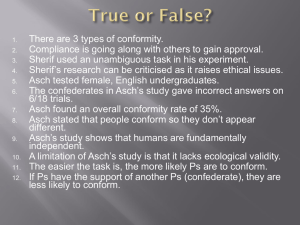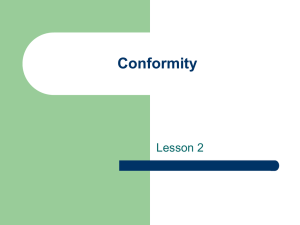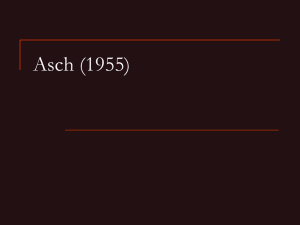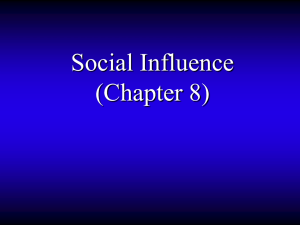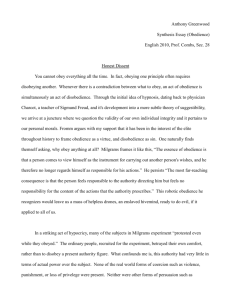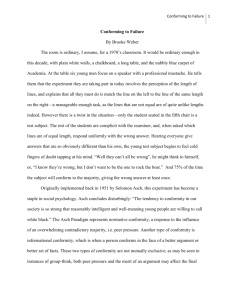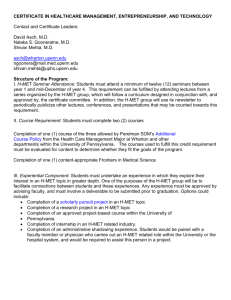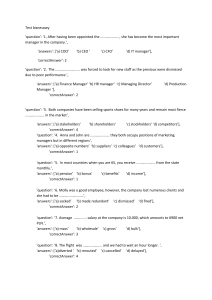Studies of conformity
advertisement
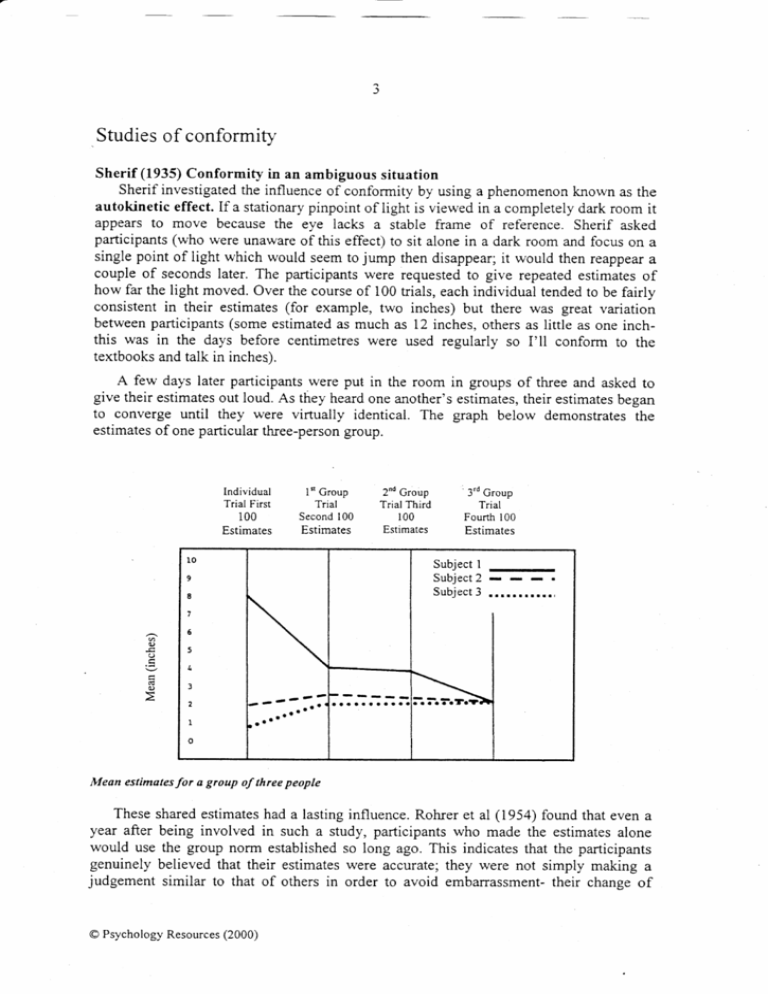
Studiesof conformifv Sherif (1935)Conformify in an ambiguoussituation Sherif investigatedthe influenceof conformity by using a phenomenonknown as the autokinetic effect.If a stationarypinpointof light is viewedin a completelydark room it appears to move becausethe eye lacks a stable frame of reference. Sherif asked participants(who were unawareof this effect) to sit alone in a dark room and focus on a singlepoint of light which would seemto jump then disappear;it would then reappeara couple of secondslater. The participantswere requestedto give repeatedestimatesof how far the light moved. Over the courseof 100 trials, eachindividual tendedto be fairly consistentin their estimates(for example, two inches) but there was great variation betweenparticipants(some estimatedas much as 12 inches,others as little as one inchthis was in the days before centimetreswere used regularly so I'll conform to the textbooksand talk in inches). A few days later participantswere put in the room in groups of three and askedto give their estimatesout loud. As they heardone another'sestimates,their estimatesbegan to converge until they were virtually identical. The graph below demonstratesthe estimatesof one particularthree-persongroup. lndividual Trial First 100 Estimates ltt Group Trial Second100 Estimates 2ndGroup Trial Third 100 Estimates lo SubjectI Subject 2 Subject3 9 I - I ' I (n () 3'dGroup Trial Fourth 100 Estimates I ! 6 5 4 0.) z 3 r--___ 2 I aaaaaaaaaaa :--:':';' o Mean estimatesfor a group of three people Thesesharedestimateshad a lasting influence.Rohrer et al (1954) found that even a year after being involved in such a study, participantswho made the estimatesalone would use the group noffn establishedso long ago. This indicatesthat the participants genuinely believed that their estimateswere accurate;they were not simply making a judgement similar to that of others in order to avoid embarrassment-their changeof (2000) O PsychologyResources 4 opinionwas internalised.In very ambiguoussituationssuch as this, peoplestrive to be accurateby usingthejudgementsof orhers. Evaluatton.'Sherif has beencriticisedfor using a situationthat was ambiguous,unusual and unlikely to reflect a real life situation.In his defence,however, there are many everydaysituationsin which we are not sure of the correctanswer and turn to othersfor guidance.If you arenot surewhat is the quickestway of doing somethingon a compurer, you ask for guidancefrom someonewho you trustto know more than you do. If a sicond personagrees,you are evenmorelikely to be convincedby the advice. There were three conditionsprevailing in Sherifs study that stackedthe deck in favour of conformity-high ambiguity,no physicalmeansof testingreality and no single correctanswer.Despiteargumentsto the contrary,theseconditionsdo prevailoutsidethe laboratoryand often involve importantdecisions-the best site for u po*.r station;the safestdesignof a car seat;the bestway of testingmedicines.Ratherthan a criticism,we shouldregardthe type of situationusedby Sherif as a limitation- he did not investigate conformityto unambiguoussituationsor to opinionsandattitudes. We will now tum our attentionto the effect of conformityin situationsthat are clear cut and unambiguous. A s c h ( 1 9 5 1 ,1 9 5 6 ) of the participantsin Sherif s study was due to Asch believedthat the suggestibility' the taskbeingambiguous;he believedthat socialinfluencewould be virtually eliminated when the task was unambiguousand the answerclearto everyone.His findings did not quite correspondto his expectations. Asch led participantsto believethatthey weretakingpart in a study of the perception of line length.In the originalstudy,the naive participant,a male student,was sat rounda table with six othersin the secondto last position.Eachindividual was askedin turn to judge the length of a standardline by cornparingit to threeothers and then statingthe answerout loud and in order round the table.The task was very easy-only thosewith extremelypoor eyesightwould havehad a problemestimatingthe correctanswer. TestLine Thelinesusedin Asch'sstudv (2000) Resources O Psychology A B C of the Unknown to the single participant,all the other studentswere confederates Imagine you are experimenter,primed to give the wrong answeron certaincrucial trials. the answer you gives that single genuineparticipant. On the first few trials, everyone simple if a expectand you ugr.. with them, probablyjudging the exerciseas extremely before and answer little boring. Th; all of a suddin the first person gives a wrong answer' you've had time to take this in the secondpersonhas giv.enthe same incorrect do you answer And so it goes on. you feel uncomfortable,confusedand embarrassedgo along with the you do or with what seemsto you to be the obvious correct answer judgementmadebY everyoneelse? cartoon of Asch's studY,bY RoYHunt the incorrect In Asch's original study, there were 12 critical trials per participantand participants answerwas giv.i on n.*iy 37 per cent of all trials. Three quartersof_the 25 per cent yieldedto grouppressureuf l.urionce; half on six or more of the trials. Only of their evidence the lf tr,. part[ipants consistentlystuck to their guns and did not deny The 37% refers own .y.r. (Be careful to distinguishbetweenthesetwo setsof findings. us tells nothing about to the total numberof cruciat triats on which peopleconformedbut percentageof people the number of participantswho conformed.ihe 75% refers to the who conformedat leastone)which people Asch checkedthat the task was easyby settingup a control condition in judged the line lengths when alone. In this condition there was a negligible number of conformedto wrong answers(0.7%).There seemsto be no doubt that when participants contrary to the wrong answers,theY must have known that they were giving an answer one that they perceivedto be correct. interviewed Why did so many people conform when the task was so easY?Asch participantsand was given a variety of answers' (2000) @ PsychologyResources 0,,+6,*u' t^Jbd;dfrs"ti ,o(hcryg"h somewent aiong '"viththe group becausethe;rwere bewiideredand afraid of looking stupidor ridiculous;they'simpryrvantedto be like everyoneeise. somethoughtthey were correctbut lverenot sure, otherssaid they beganto doubt their own eyes and that the majcrity rvasgenerally correct. Even thosewho remainedindependentsaid they' feh extremely uncomfortableand tried to work out exactlywhat was happening. On the basisof thesefindings, Asch concludedthat 'people submit uncriticallyand painlesslyto externaimanipulationby suggesrion'(1955,p. iz1 u, did, however,point out that independence is alsoan option and that rveneedto considerthe conditionswhich encourageand discourageconformity. With this in mind, he cond.ucted.several variationson his original study,the designand findingsof which we will now consider. l. Varyingthe size of the maioriQ. By varying the number of confederates, Asch found that conformity d.roppedto an extremelylow level (less than 4%) when there was only one confederate,but rosequite shaqplyonce the participantwas in the minority. With two confederates, the conformityrut. was 13.6%,with threeit was nearly 3z%. After that it rose very little, reachingthe maximum in a seven-person groups.Even a majority of 15 did not increaseit further.This indicatesthat a majority of threeis the criticalpoint and afterthat increasesin the majority have little effect. 2 . One confederateansweredcorrectly. Conformityiates droppeddramaticaliy to 6 per cent. 3 . One confederateanswereddiferently but incorrectly. Conformitydid not drop as sharplybut was considerablyreduced. This indicatesthat evenif no-on. agreeswith your judgement,you feel betterableto expressit if you ".ruulfvare not the only 'odd-one-out'. t 4 . The task was made more dfficult. As you might expect, conformity rose quite sharply. Evaluation"Asch's researchon conformity has demonstrated that conformity still occurs in situationsin which the correctansweris obvious.He therefore showed convincingly and to his own surprisethat group pressuresto conform are much stronger than had previouslybeenappreciated. Asch hasbeencriticisedfor usingrnalecollegestudentsas his participants, sincethis is not a representative sampleof the population.Hi, resultsmay also not generalise to other times, to other groups such as women and to other cultures. We will consider studiesdealingwith thesefactorsshortly. Asch (and Sherif) only investigatedconformity under conditions in which physical stimuli were beingjudged and not in situationsthat challengeddeeply held anitudesand values'We cannotbe sure thatjudgementsaboutphysicalstimuli are liable to be subject to social pressurein the same way as are attitudes.Their results cannot thereforebe generaiised to suchsituations. One of the problemsof any study conductedin the confinesof a laboratory or similar artificial environmentis that it may lack ecologicalvalidify, that is, it may not reflect @ Ps y c h o l o g yR e s o u rc e(2 s 000) 'behaviour two in a real worid situation.Aronson& Carlsmith(i986) havedistinguished ways in which laboratoryexperimentation ma,)-lack realism. Cne is experimental realism. An experimentis said to be realisticif the sin:ationwhich it presentsto the participantis realistic,if it engagesthem and has an impact on them. Robson(i993) arguesthat Asch's studyon confonnit.vshowedexperimentairealismin the sensethat the which causedthem to show strongsignsof participantswere undergoingan experience tension and anriety, indicating that they were reacting to the situation in the same realistickind of way they rvouldoutsidea laboratory. The other kind of realismidentifiedby Aronson & Carlsmithis that of mundane in the laboratoryareliable to occur realism, the extentto which the eventsencountered in the outsideworld. Asch's study could be criticisedon its lack of mundanerealism becausethe study involved a very simplestructuredsituationwhereasany such situation in a real life sening would be far more complexand ambiguousand would probably resultin findingswhich weremuch lessconclusive. ethicalproblemswith Asch's research.Firstly, as in many There are considerable social psychologicalstudies,the participantswere deceivedas to the purposeof the study.Secondly,whetheror not participantsconformed,they felt very uncomfortableand were concernedabout appearingfoolish.The physiologicaleffectsinvolved in such a by Bogdonoffet al (1961).who foundthatarousallevels tensesituationwereinvestigated were high in all the participantsonce they were faced with the opposingjudgementsof Thesehigh levelsof arousalwere maintainedin participantswho held the confederates. firm to their own judgementsbut did drop in thosew'hoconformed. Crutchfield (1954,55): conformify in private Crutchf-reldused a method of studying conformity that was much more etficient and ethicalthan that usedby Asch. It was more practicalbecausemany participantscould be testedquickly on a large variety of tasks.It was more ethical becauseparticipantswere not put in such an embarrassingsituation(althoughthey were deceivedas to the purpose of the study). In these studies,participants(usualiy five at a time) sat in separatebooths with a panel of switches and lights in front of them. One set of lights, when illuminated, indicated the supposedresponsesof the other four participantsand a set of switches provided them with the meansof giving their own responsefrom a multiple-choice picturesor otherstimuli were projectedon to a screenin selection.Questions,statements, front of them and they were requiredto give their responselast, so they had alreadyseen the supposedresponsesof others.Theseresponseswere entirely false, the lights having been operatedby the experimenter.In this way a bogus majority was establishedon certaincrucial items (obviouslynot on all of them or this would alert the participantsthat somethingfishy was involved). Over 600 participantswere tested, including students,women and army officers attending a three-day assessmentprogramme. The stimuli used were quite varied, itemssimilarto thoseon I.Q. testsand onessimilarto those includingattitudestatements, usedby Asch. In many ways the resultsobtainedby Crutchfieldwere evenmore dramaticthan those of Asch. Someof them areas follows. . Participantswere askedto comparethe size of a circle and star,the circle being much the largerof the two. 46%conformedto the inconect mijority response. The group of anny officers had all said privately that they believedthey would make session!).Yet no fewer than good leaders(as you would expecton an assessment 37% agreedwith a bogusmajority statementthat they would not make a good leader. When the bogusmajority agreedwith the statement'Freespeechbeing a privilege ratherthan a right, it is properfor a societyto suspendfree speechwhen it feels itself threatened', 58Yoof studentparticipantsagreed.This is a very worrying finding. On Asch-typeperceptualtasks,conformity was 30% (it is surprisingthat this was so closeto Asch's own findings,given the relativeprivacy of the situation). Evaluation: As already mentioned,Crutchfield's study was more efficient and ethical than was Asch's, but there are still some ethical concerns.Obviously deceptionwas involved and there was evidenceof discomfort and embalrassment.For example,when interviewedafter the study, someof the participantswho had kept their judgementsand had their self confidenceseverelyshaken. not conformedat all had nevertheless Another problem with thesestudiesis that a substantialproportion of the participants (17%) indicatedthat they knew what was going on and were aware of the deception. Obviously this would affect the results,but it was not clear from the researchpaperjust what this affect may have been. (2000) @ PsychologyResources

